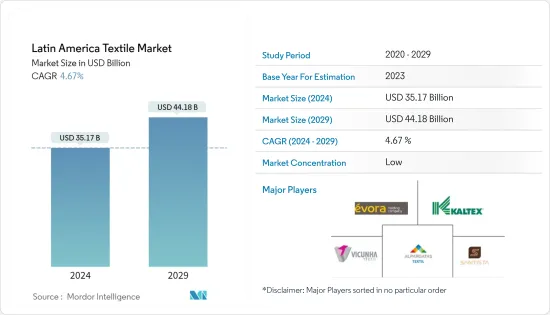PUBLISHER: Mordor Intelligence | PRODUCT CODE: 1433866

PUBLISHER: Mordor Intelligence | PRODUCT CODE: 1433866
Latin America Textile - Market Share Analysis, Industry Trends & Statistics, Growth Forecasts (2024 - 2029)
The Latin America Textile Market size is estimated at USD 35.17 billion in 2024, and is expected to reach USD 44.18 billion by 2029, growing at a CAGR of 4.67% during the forecast period (2024-2029).

The COVID-19 pandemic, which has caused major disruptions to the international trade flows and global economy, has resulted in a sudden drop in textile productivity in the Latin American region. The pandemic has largely impacted the region. The Mexican textile and clothing market, which is one of the top markets in the region, has been operating the entire supply chain from cotton and other man-made fiber production. Mexico being one of the key suppliers of textiles and clothing to the United States, which sends a large proportion of its textile and related product exports to the United States, has been facing difficulties in manufacturing due to the lockdown and other safety measures. The situation is expected to get back to the pre-COVID-19 scenario slowly, yet the market is anticipated to register a slow growth rate during the forecast period.
Latin America is home to some major textile-producing nations, such as Peru, Brazil, and Colombia. Peru is South America's biggest clothing exporter, and it boasts of unique domestic raw materials, especially alpaca fiber and Tanguis cotton. Brazil, a BRIC country, has enormous growth potential in both its textile supply chains, natural fibers and man-made fibers. Colombia is also expected to witness great opportunities in the textile and fashion market. Meanwhile, the CAFTA-DR countries - Costa Rica, Dominican Republic, El Salvador, Guatemala, Honduras, and Nicaragua - are eagerly competing among themselves and against Haiti for niches in the US market.
Latin American Textiles Market Trends
Changing Dynamics of the Latin American Fashion Retail is Helping the Market Grow
Latin America and the Caribbean are emerging as potential growth markets, driven by the increasing domestic demand, economic growth, and purchasing power. Investment possibilities in Latin American countries, such as Brazil, Mexico, Argentina, Colombia, Venezuela, Chile, Peru, Ecuador, the Dominican Republic, and Uruguay, are abundant. The popularity of the American lifestyle and the strong influence of the United States on the culture and consumption patterns in Latin America wooed fashion names, like Tommy Hilfiger and Nike, to launch their retail operations in Mexico and Brazil. Spanish fashion verticals, like Inditex and Mango, changed the way people in Latin America shopped, pushing the domestic fashion retailers to focus on product quality and offerings.
Increasing Cotton Production is Helping the Market Record Growth
The production of organic cotton has been increasing worldwide, including in Latin America and the Caribbean region. The region registered a significant growth rate of 27% during 2018/19 and accounted for around 0.3% of the global organic cotton production. The region recorded a growth of a total of 666 metric ton (MT) of organic cotton fiber, which has great potential for substantial growth. Cotton production stemmed from the leading Latin American countries during the period where Argentina achieved 10.8 MT, followed by Brazil with 97 MT and Peru with 558 MT.
Latin American Textiles Industry Overview
The report covers the major players operating in the Latin America textile market. In terms of market share, the companies in the textile market do not have considerable shares, as the market is competitive and moderately fragmented.
Additional Benefits:
- The market estimate (ME) sheet in Excel format
- 3 months of analyst support
TABLE OF CONTENTS
1 INTRODUCTION
- 1.1 Study Assumptions and Market Definition
- 1.2 Scope of the Study
2 RESEARCH METHODOLOGY
3 EXECUTIVE SUMMARY
4 MARKET INSIGHTS AND DYNAMICS
- 4.1 Market Overview
- 4.2 Market Drivers
- 4.3 Market Restraints/Challenges
- 4.4 Market Opportunities
- 4.5 Value Chain/Supply Chain Analysis
- 4.6 Industry Attractiveness - Porter's Five Forces Analysis
- 4.7 Technological Innovation in the Industry
- 4.8 Impact of COVID-19 on Latin America Textile Industry
5 MARKET SEGMENTATION
- 5.1 By Application
- 5.1.1 Clothing
- 5.1.2 Industrial/Technical Applications
- 5.1.3 Household Applications
- 5.2 By Material
- 5.2.1 Cotton
- 5.2.2 Jute
- 5.2.3 Silk
- 5.2.4 Synthetics
- 5.2.5 Wool
- 5.3 By Process
- 5.3.1 Woven
- 5.3.2 Non-woven
6 COMPETITIVE LANDSCAPE
- 6.1 Market Competition Overview
- 6.2 Company Profiles
- 6.2.1 Evora SA
- 6.2.2 Kaltex SA
- 6.2.3 Vicunha Textil SA
- 6.2.4 Coteminas SA
- 6.2.5 Alpargatas SAIC
- 6.2.6 Santista Argentina SA
- 6.2.7 Santana Textiles SA
- 6.2.8 Fabricato SA
- 6.2.9 Pettenati SA Textile Industry
- 6.2.10 Australtex SA*
7 FUTURE OF THE MARKET
8 DISCLAIMER




